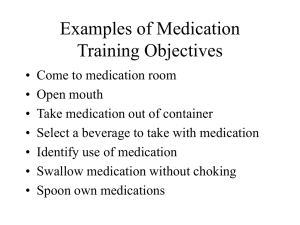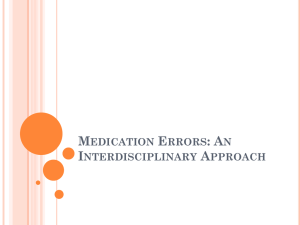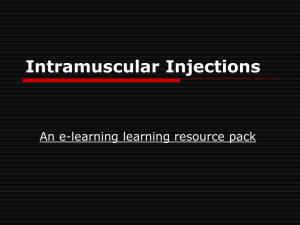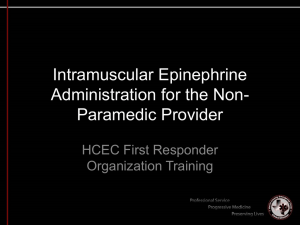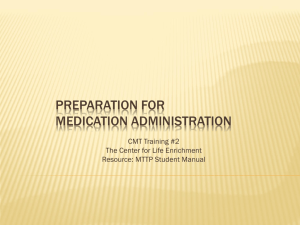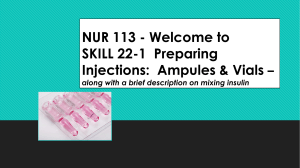Preparing Medications for Administration by Injection
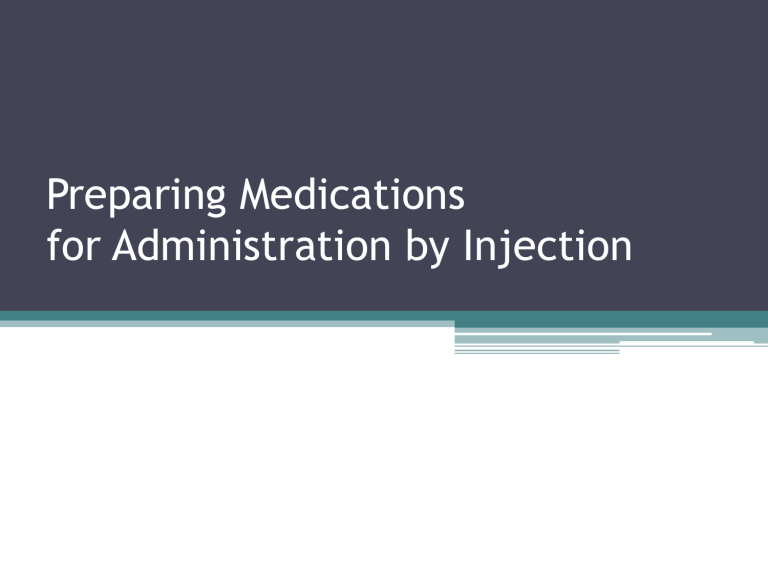
Preparing Medications for Administration by Injection
Ampules
• Is a glass flask that contains a single dose of medication for parenteral administration
• If not all the medication is used, the remainder must be discarded
• Medication is removed from an ampule after its thin neck is broken.
• The ampule can be inverted or placed on a flat surface to draw the solution into the syringe.
• Care must be taken not to contaminate the needle by touching the rim of the ampule
Vials
• Is a glass bottle with a self sealing stopper through which the medication is removed.
• For safety in transporting and storing, the single-dose rubber capped vial is usually covered with a soft metal cap that can be removed easily.
• The rubber stopper that is then exposed is the means of entrance into the vial.
Vials
• Some drugs are dispensed in vials that contain several doses.
• To prevent microbial growth in the vial, each multidose vial is usually good for only 24 hours.
• Label the vial with the time and date when first used.
• After the initial use of the multidose vial, wipe the rubber stopper with alcohol each time of use.
• To facilitate removal of medication, inject air into the vial.
• The amount of air injected into the vial is the same amount as the desired quantity of solution.
Mixing Medications in One Syringe
• Preparation of medications in one syringe depends on how the medication is supplied.
• When using a single-dose vial and a multidose vial, air is injected into both vials and the medication in the multidose vial is drawn into the syringe first.
• This prevents the contents of the multidose vial from being contaminated with the medication in the single-dose vial.
• First, it is important to ensure that the two drugs are compatible.
• When preparing medications from an ampule and a vial, the medication in the vial is prepared first.
• The medication in the ampule is drawn up after the medication in the vial.
• Nurses must be aware of drug incompatibilities when preparing medications in one syringe.
• Mixing more than two drugs in one syringe is not recommended.
Mixing Insulin's in One Syringe
• Insulin, a naturally occurring hormone produced by the islets of Langerhans in the pancreas, enables cells to use carbohydrates.
• Patients with diabetes mellitus produce no insulin or produce insulin in insufficient amounts.
• Several types of insulin are available for use by patients with diabetes mellitus.
• Insulin's vary in their onset and duration of action and are
Classifications of Insulin
1.
Short acting, regular insulin is clear,
2.
Intermediate acting, intermediate- or long-acting insulins are cloudy
3.
Long acting.
Before administering any insulin, the nurse should be aware of the onset time and ensure that proper food is available.
• Insulin dosages are calculated in units.
• 100 units of insulin contained in 1 mL of solution.
• Due to the small amounts of insulin to be administered in children, the physician may order a special concentration made by the pharmacist, such as U25 (25 units of insulin in 1 mL of solution).
• An insulin syringe is calibrated in units also.
• Many cases of diabetes mellitus are regulated with a combination of two insulins (eg, regular and NPH insulins).
• The importance of rotating injection sites for insulin administration cannot be overemphasized.
• A 10-mL vial of unrefrigerated insulin may be used safely for 1 month if stored in a cool place.
• If stored in the refrigerator, it may be kept for 3 months
Reconstituting Powdered Medications
• The technique of adding a diluent to a powdered drug .
• Actovials have the diluent and powder in the same vial but separated by a rubber stopper.
• When the nurse is ready to administer the medication, the rubber stopper is deployed and the actovial is gently agitated to mix the diluent and powder.
Administering Medications
Intradermally
• The intradermal route has the longest absorption time of all parenteral routes.
• Used for diagnostic purposes, such as the tuberculin test and tests to determine sensitivity to various substances.
• The advantage of the intradermal route for these tests is that the body’s reaction to substances is easily visible.
Administering Medications
Intradermally
• Intradermal injections are placed just below the epidermis.
• Sites commonly used are the inner surface of the forearm, the dorsal aspect of the upper arm, and the upper back.
• The dosage given intradermally is small, usually less than 0.5 mL
Administering Medications
Subcutaneously
• Subcutaneous tissue lies between the epidermis and the muscle.
• Because there is subcutaneous tissue all over the body, various sites are used for subcutaneous injections.
• These sites are :
1.
the outer aspect of the upper arm
2.
the abdomen (from below the costal margin to the iliac crests)
3.
the anterior aspects of the thigh
4.
the upper back
5.
the upper ventral or dorsogluteal area.
• This route is used to administer insulin, heparin, and certain immunizations
Administering Medications
Subcutaneously
• Equipment used for a subcutaneous injection depends on the medication to be given.
• For insulin ; insulin syringe.
• Heparin is prepared with a tuberculin syringe or supplied in a prefilled cartridge.
• Ordinarily, no more than 1 mL of solution is given subcutaneously.
Administering Medications
Subcutaneously
• The skin is cleaned for a subcutaneous injection in the same manner as for an intradermal injection.
• Research has questioned the need to clean the skin with an alcohol prep before an insulin injection.
• The combination of a small-gauge needle that limits the number of bacteria that can pass through it and bacteriostatic additives in insulin preparations makes skin preparation before an insulin injection unnecessary, but this cleansing is still commonly performed
Administering Medications
Subcutaneously
• Choose the angle of needle insertion based on the amount of subcutaneous tissue present and the length of the needle.
• Decide the angle according to the needle size and the patient’s size.
For a thin patient, it is best to bunch the skin to create a skin fold and insert the needle at a 45degree angle.
Administering Medications
Subcutaneously
• The risk for injecting a medication intramuscularly is lower for a heavier person, and a 90-degree angle may be used.
Heparin administration
• It is administered subcutaneously
• The abdomen is the most commonly used site.
• The area around the umbilicus and the belt line must be avoided.
• For low-molecular weight heparin preparations:
1.
Pinch the tissue gently
2.
Insert the needle at a 90-degree angle into a fat pad on either side of the abdomen.
3.
Aspiration or pulling back on the plunger is not recommended with administration of heparin because this action can result in hematoma formation.
Administering Medications
Subcutaneously
• In the case of heparin and insulin massaging the site can increase the rate of absorption of these agents.
• It is necessary to rotate sites or areas for injection if the patient is to receive frequent injections( this helps to prevent buildup of fibrous tissue and permits complete absorption of the medication).
• Insulin is absorbed most quickly in the abdomen, followed by the arms, thighs, and buttocks.
Administering Medications
Subcutaneously
• In each case, the injections should be given an inch away from the previous injection site.
• The site of administration is to be recorded.
• Insulin, may be administered continuously via the subcutaneous route.
Administering Medications
Intramuscularly
• The IM route is often used to administer drugs that are irritating, because there are few nerve endings in deep muscle tissue.
• Palpate a muscle before injection and select a site that does not feel tender.
• Absorption occurs as in subcutaneous administration but more rapidly because of the greater vascularity of muscle tissue.
• Five milliliters is considered the maximum to be given in one site for an adult with well-developed muscles, patient’s size and the site used (eg, deltoid muscle) may require a smaller amount (Nicoll & Hesby, 2002).
Complications of intramuscular injection
Select a safe site away from large nerves, bones, and blood vessels.
• Common complications are:
1.
Abscesses
2.
Necrosis
3.
Skin slough
4.
Nerve injuries
5.
Lingering pain تباث
6.
Periostitis (inflamation of the membrane covering a bone).
The sites for injecting intramuscular medications should be rotated when therapy requires repeated injections.
Intramuscular Injection Sites
• Ventrogluteal Site. The ventrogluteal site involves the gluteus medius and gluteus minimus muscles in the hip area. The ventrogluteal site is recommended for both adults and children older than 7 months of age as a safe site for most intramuscular injections:
1.
There are no large nerves or blood vessels in the injection area
2.
The site is removed from bone tissue
.
3.
The area is clean (fecal contamination is rare at this site)
4.
The patient can be on the back, abdomen, or side for the injection.
To relax the gluteal muscle
1.
The patient may flex the knees while lying on the back.
2.
Point the toes inward while lying in the prone position
3.
Flex the upper leg in front of the lower leg in the side-lying position.
To locate the ventrogluteal site
• Place the palm of your hand over the greater trochanter, with your fingers facing the patient’s head.
• The right hand is used for the patient’s left hip, or the left hand for the right hip, to identify landmarks.
• The index finger is placed on the anterosuperior iliac spine and the middle finger extends dorsally, palpating the crest of the ilium.
• A triangle is formed, and the injection is given in the center of the triangle.
Vastus Lateralis Site
• It is recommended frequently for the injection if the ventrogluteal site cannot be used
• It is a thick muscle, and there is little or no danger of serious injury.
• There are no large nerves or vessels, and it does not cover a joint.
• The thigh is divided into thirds horizontally and vertically, and the injection is given in the outer middle third.
Vastus lateralis
• This space provides a large number of injection sites.
• It is desirable for infants and children, whose gluteal muscles are poorly developed.
• It can be accessed easily while restraining an infant.
Deltoid Muscle Site
• The deltoid muscle is located in the lateral aspect of the upper arm.
• It is not often used because it is a small muscle and is not capable of absorbing large amounts of solution.
• Damage to the radial nerve and artery is a risk of the deltoid site.
• Intramuscular injections into the deltoid muscle should be limited to 1 mL of solution and given only for adults.
• The deltoid muscle is not developed enough in infants and children.
Deltoid Muscle Site
• The deltoid muscle can be located by palpating the lower edge of the acromion process.
• A triangle is formed at the midpoint in line with the axilla on the lateral aspect of the upper arm.
• Hepatitis B virus vaccine is one medication that should be given in the deltoid muscle in adults to induce adequate levels of the antibody.
Dorsogluteal Site
• The dorsogluteal site located in the buttock
• A common site for administering intramuscular injections.
• Because of the potential for injury to the sciatic nerve and the presence of major blood vessels and bone mass near the site, the dorsogluteal muscle is not recommended.
Dorsogluteal Site
• An imaginary line is drawn between the posterosuperior iliac spine and the greater trochanter.
• The injection site is lateral and slightly superior to the midpoint of the line.
• It should not be used for children younger than 3 years of age because their gluteal muscles are too small.
Dorsogluteal Site
• Good visualization of the entire area and careful mapping are necessary to locate the proper site.
• This necessitates adequate exposure by lowering the undergarments.
Dorsogluteal Site
• The patient should be in a prone position with the toes pointed inward, or in the side-lying position with the upper knee flexed and the upper leg in front of the lower leg.
• This site should not be used with the patient in a standing position because the gluteus muscle is tense.
The dorsogluteal site is lateral and slightly superior to the midpoint of a line drawn from the trochanter to the posterior superior iliac spine
Intramuscular Injection Procedure
Z-track technique
• Any intramuscular injection may be given.
• This method prevents seepage of the medication into the needle track
• Reduces pain and discomfort
• Advised for elderly patients who have decreased muscle mass
• Some agents, such as iron, are best given via the
Z-track method due to the associated irritation and discoloration.
Z-track technique
• The ventrogluteal, vastus lateralis, or dorsogluteal site can be used for this procedure.
• The skin is pulled down or to one side about (2.5 cm) and held in this position with the left hand (for a right-handed person).
• The needle is inserted and the nurse aspirates carefully to detect the presence of blood.
• The medication is injected slowly,
• The needle is steadily withdrawn, and the displaced tissue is released and allowed to return to its normal position.
• Massage of the site is not but gentle pressure may be applied with a dry sponge.
Reducing Discomfort in Subcutaneous and Intramuscular Administrations
1.
Select a needle of the smallest gauge that is appropriate for the site and solution to be injected, and select the correct needle length.
2.
Be sure the needle is free of medication that may irritate superficial tissues as the needle is inserted. Recommended procedure is to use two needles—one to remove the medication from the vial or ampule and a second one to inject the medication.
Reducing Discomfort in Subcutaneous and Intramuscular Administrations
3. Use the Z-track technique for intramuscular injections to prevent leakage of medication into the needle track, thus minimizing discomfort.
4. Inject the medication into relaxed muscles. There is more pressure and discomfort when the medication is injected into a contracted muscle.
5. Do not inject areas that feel hard on palpation or tender to the patient.
6. Insert the needle with a dartlike motion without hesitation, and remove it quickly at the same angle at which it was inserted.
Reducing Discomfort in Subcutaneous and Intramuscular Administrations
• Do not administer more solution in one injection than is recommended for the site.
• Inject the solution slowly so that it may be dispersed more easily into the surrounding tissue (10 seconds per 1 mL).
• Apply gentle pressure after injection, unless this technique is contraindicated.
Reducing Discomfort in Subcutaneous and Intramuscular Administrations
• Allow the patient who is fearful of injections to talk about his or her fears. Answer the patient’s questions truthfully
• Taking the time to offer support often allays fears and decreases discomfort.
• Rotate sites when the patient is to receive repeated injections.
Administering Medications
Intravenously
• It have an immediate effect.
• The intravenous route is the most dangerous route of administration:
because the drug is placed directly into the bloodstream
Intravenous administration is the route used in most emergency situations
Ways to administer medications intravenously
• Medications may be added to the patient’s infusion solution.
• Medication may be administered by continuous infusion
• Medications via an Intravenous Bolus or
Push.
Medications via Intermittent
Intravenous Infusion
• Medications can be administered by intermittent intravenous infusion.
• The drug is mixed with a small amount of the intravenous solution, such as 50 to 100 mL, and administered over a short period at the prescribed interval (eg, every 4 hours).
Administration of medications through intravenous line:
• A piggyback setup
• A volume-control administration set
• A mini-infusion pump.
• The intravenous piggyback delivery system requires the intermittent or additive solution to be placed higher than the primary solution container.
• An extension hook provided by the manufacturer provides for easy lowering of the main intravenous container.
Medications administration by a controlled-volume set
• The medication is diluted with a small amount of solution and administered through the patient’s intravenous line
• This type of equipment is also used for infusing solutions into children and older patients when the volume of fluid infused must be monitored carefully.
•
The minisyringe pump for intermittent infusion is battery operated and allows medication mixed in a syringe to be connected to the primary line and delivered by mechanical pressure applied to the syringe plunger.
Heparin lock
• A heparin or saline lock, or intermittent venous access device, is used for patients who require intermittent intravenous medication but not a continuous intravenous infusion.
• An intravenous lock allows the patient more freedom than a continuous intravenous infusion.
• A saline flush rather than a heparin flush is used
Heparin lock
• Using saline eliminates any possible systemic effects on coagulation, development of a heparin allergy, and drug incompatibility, which may occur when a heparin solution is used.
• The intermittent infusion is not started until the nurse confirms intravenous placement.
• The saline lock is flushed after the infusion is completed to clear the vein of any medication and to prevent clot formation in the needle.
• If infiltration or phlebitis occurs, the lock is removed and replaced in a new site.
Intravenous medication
• Intermittent intravenous medication may be administered through a centrally placed line into the
subclavian or internal jugular veins or through a peripherally inserted central catheter (PICC).
• Laminar flow is a technique that helps regulate airflow to prevent bacterial contamination and collection of hazardous chemical fumes.
• Aseptic technique is observed when the nurse administers medications through a central intravenous line.
• All connections are cleaned with povidone-iodine or an antiseptic agent.
Administering Topical Medications
• When a drug is applied directly to a body site, it is called a topical application.
• Topical applications are usually intended for direct action at a particular site, although some systemic effect may also occur.
• The action depends on the type of tissue and the nature of the agent.
• If the site of application accessible, such as the skin, an agent can easily be placed on it. If it is a cavity, such as the nose, or is enclosed, such as the eye, a mechanical applicator is needed to introduce the drug.
Skin Applications
Functions of the skin;
• The skin is a mechanical and chemical barrier that protects the underlying tissues.
• It is a sense organ, with receptors that respond to touch, pain, pressure, and temperature.
• The skin helps in excretion
• Regulating body temperature
• Storing essentials to the body, such as water, salts, and glucose.
Typical preparations that are applied to skin areas:
• Powders are used to promote drying of the skin and prevent friction on the skin.
• Ointments provide prolonged contact of a medication with the skin and soften the skin. They are usually thoroughly massaged into intact skin.
• Creams and oils lubricate and soften the skin and prevent drying of the skin.
• Lotions protect and soothe the skin. Shake lotions thoroughly before using.
The transdermal route
• The transdermal route is being used more frequently to deliver medication.
• Transdermal patches are commonly used to deliver hormones, narcotic analgesics, and nicotine.
• Medication errors have occurred when patients applied multiple patches at once or failed to remove the overlay on the patch that exposes the skin to the medication.
• Narcotic analgesic patches are associated with the most adverse drug effects.
Eye Instillations and Irrigations
• The sclera ; The outer layer of the eyeball, is fibrous and tough .
• The cornea is the transparent part of the sclera in front of the eyeball, the cornea is easily injured by trauma.
• For this reason, applications to the eye seldom are placed directly onto the eyeball.
• Because direct application cannot be made onto the sensitive cornea, applications are placed onto, or instilled or irrigated into, the lower conjunctival sac.
• Although the eye is never free of microorganisms, the secretions of the conjunctiva have a protective action
• For maximum safety for the patient, the equipment, solutions, and ointments introduced into the conjunctival sac should be sterile.
Ointments
• These ointments are usually used for a local infection or irritation.
• A small amount of ointment is distributed along the lower conjunctival sac
• About 1⁄2 ″ of ointment is squeezed from the tube along the exposed sac.
• After the application, the eyes should be closed.
• The warmth helps to liquefy the ointment.
• Instruct the patient to move the eye, because this helps to spread the ointment under the lids and over the surface of the eyeball.
• Explain that the ointment may temporarily blur vision; encourage the patient not to rub the eye.
Eye Irrigation
Purposes;
• To remove secretions or foreign bodies
• To cleanse and soothe the eye.
• To remove chemicals that may burn the eye.
Tap water should be used to remove chemicals such as acid.
The irrigation should continue for at least 15 minutes
Care should be taken so that the over flowing irrigation fluid does not contaminate the other eye
Ear Instillations and Irrigations
• The ear contains the receptors for hearing and equilibrium.
• It consists of the external ear, the middle ear, and the inner ear.
• Drugs or irrigations are instilled into the auditory canal for their local effect.
Purposes;
• To soften wax
• Relieve pain
• Apply local anesthesia
• Destroy organisms
• Destroy an insect lodged in the canal
• If the ear canal has swollen to the point that medication cannot pass, a wick is inserted so that one end is near the middle ear and the other end is external. This cotton then acts as a wick to help medication get to the inner ear.
Omitted Drugs
Drugs may be omitted intentionally for the following reasons:
• The patient is to have a diagnostic test and is to fast before the test.
• The problem for which the medication is used has resolved no longer exists. For example, a laxative has been ordered for a patient. The patient has had a bowel movement and no longer needs the laxative.
The laxative is then omitted.
• The patient is suspected of having an allergy to the medication
Refused Drugs
• If the patient refuses to take a drug that is considered essential to the therapeutic regimen, report this promptly.
• The nurse can often determine the reason for the refusal and can help the patient accept needed drugs.
• Patients have the right to refuse therapy; recognize and respect that right.
• The refusal to take prescribed drugs and the manner in which the situation was managed should be described on the patient’s record and reported according to agency policy.
Medication Errors
• Inappropriate prescribing of the drug (eg, incorrect dose, quantity, or route, or inadequate instruction)
• Extra, omitted, or wrong doses
• Administration of a medication to a patient that was not ordered for him or her
• Administration of a drug by an incorrect route or at in incorrect rate
• Failure to give a medication within the prescribed time interval
• Incorrect preparation of a drug before administration
• Improper technique when administering a drug
• Giving a drug that has deteriorated
The following steps are recommended when a medication error occurs:
1. Check the patient’s condition immediately when the error is noted. Observe for the development of adverse effects related to the error.
2. Notify the nurse manager and the physician to discuss possible courses of action, depending on the patient’s condition.
3. Write a description of the error on the patient’s medical record, including remedial steps that are taken.
4. Complete the form used for reporting errors, as dictated by agency policy.
